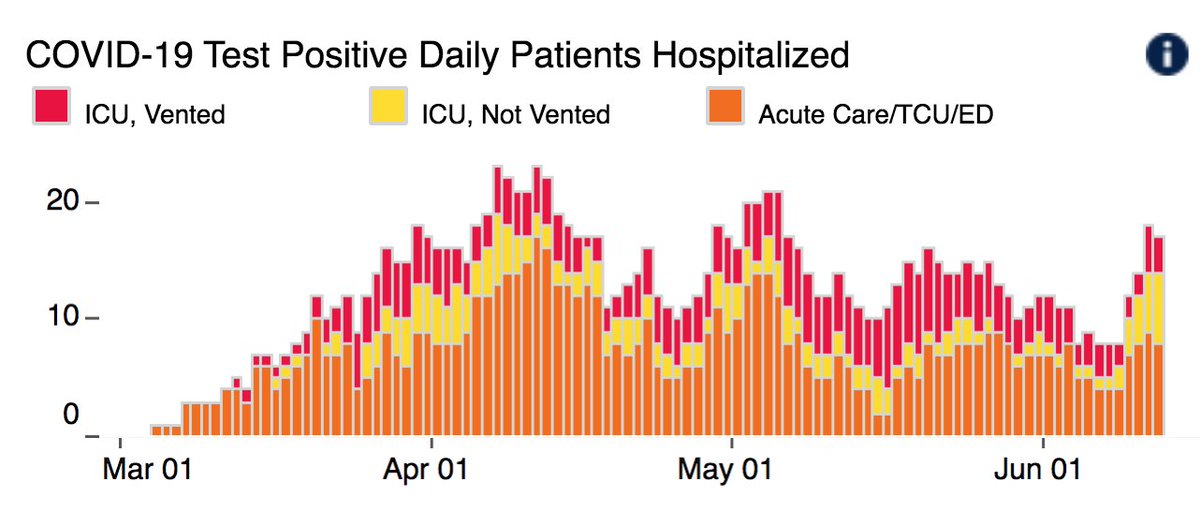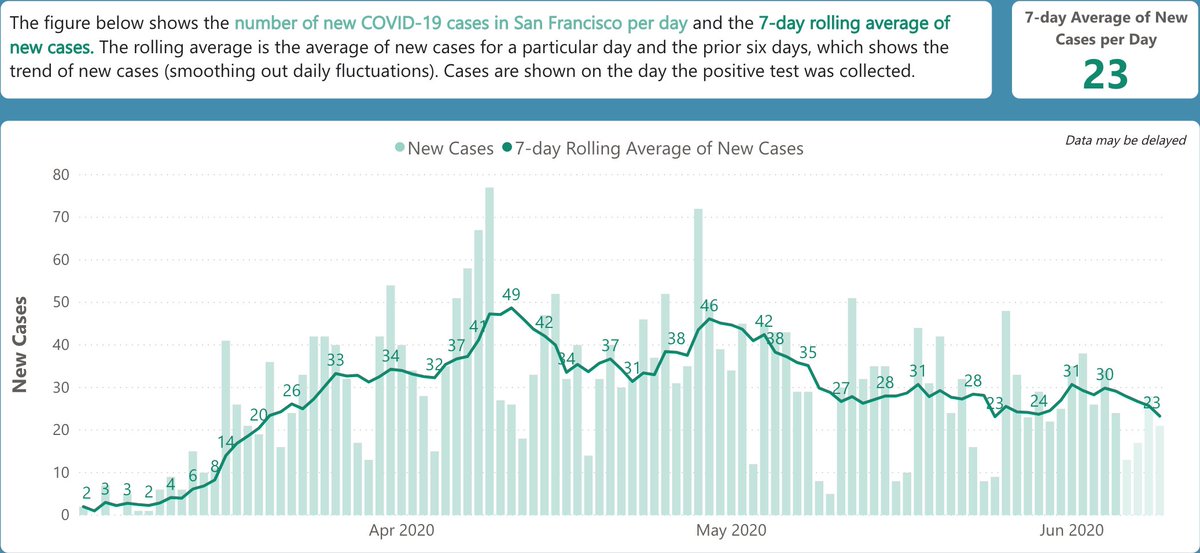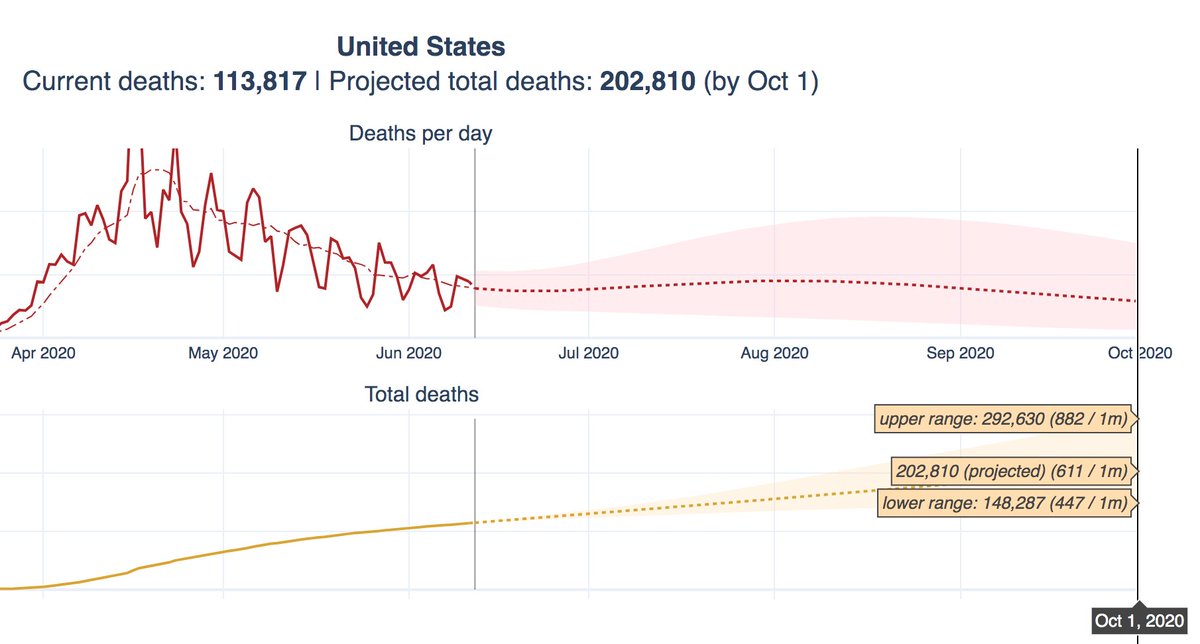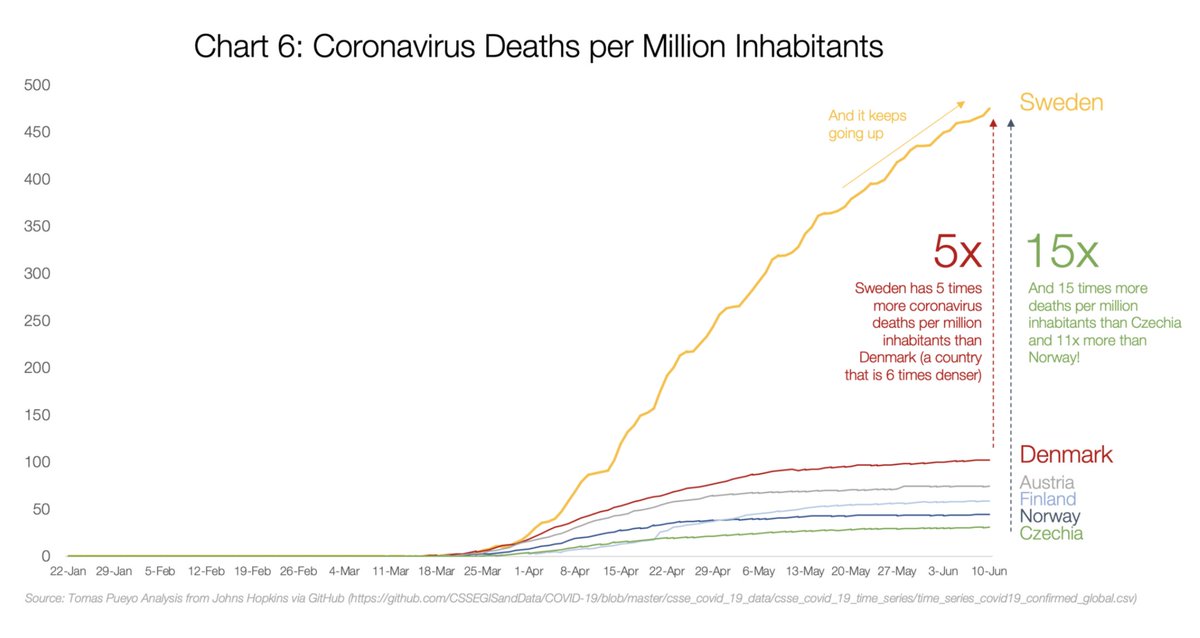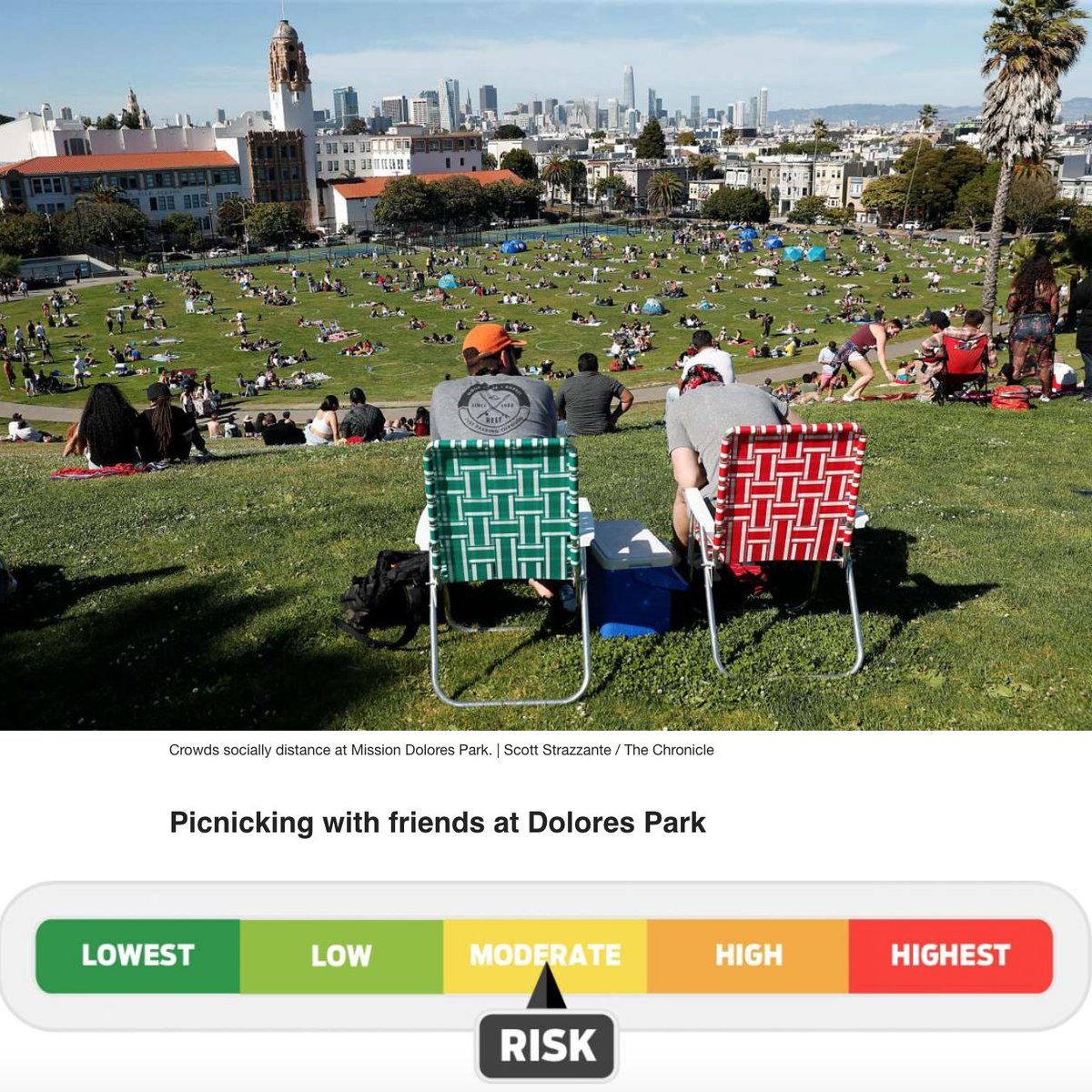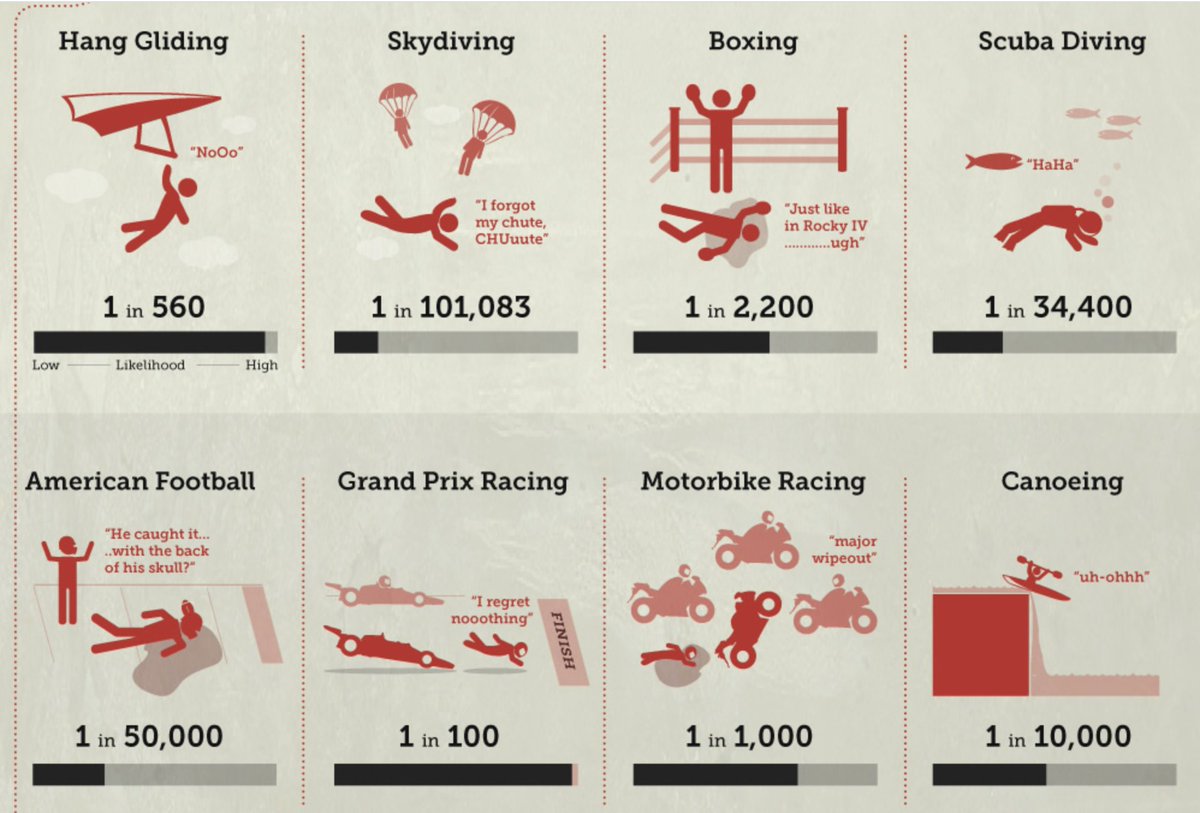1/ Covid ( @UCSF) Chronicles, Day 87
Local update: @UCSFHospitals, remains up @ 17 (double last wk), 3 vented (Fig). I still can’t explain it – no bump in posive test % (1.7%) & no new deaths (total=6). SF General's hospitalizations, higher than @UCSF’s last month, down to 8.
Local update: @UCSFHospitals, remains up @ 17 (double last wk), 3 vented (Fig). I still can’t explain it – no bump in posive test % (1.7%) & no new deaths (total=6). SF General's hospitalizations, higher than @UCSF’s last month, down to 8.
2/ And SF #’s remain stable: cases/day falling, avg 23/d (Fig on L). Just 1 death in the past 2 wks. Hospital pts low: 37, 14 in ICUs (Fig R). So I'm flummoxed – it appears that half of hospitalized patients in SF are now @UCSF, big change from 2 mths ago. Watching very closely.
3/ Today, after a few general observations, I'm going to focus mostly on assessing risk – to individuals as they make decisions, and to states & cities, as they do the same. March/April were easy: stay at home. Now there are dozens of decisions for everyone to make, every day.
4/ Yesterday, we hit 2 million cases in the U.S. Remember when Donald Trump didn’t want to let the Grand Princess come ashore because he didn’t want the case numbers added to the U.S. count? https://on.mktw.net/3cUfP4J That was March 8; the U.S. case count on that day was 433.
5/ We’re now at 116K deaths; most accurate of the models ( @youyanggu's) projects >200K deaths by Oct 1 (Fig). This time it won’t be concentrated in 1 city; it’ll be spread around – we’re beginning to see hot spots in places that were spared first time around: AZ, FL, TX, & SoCal.
6/ The evidence that the lockdown saved lives is increasingly persuasive: @nature study showed that lockdowns in 6 nations, including the U.S., prevented roughly 530 million infections, and thus, by conservative estimates, ~1-3 million deaths https://go.nature.com/2Yu6z27
7/ This superb @tomaspueyo piece on the failed Swedish “Herd Immunity” strategy shows what happens without a rapid lockdown https://bit.ly/2Yt1OGa . The article, as usual, has great graphics and stats, all documenting a tragic policy miscalculation. A great (long) weekend read.
8/ How risky is opening up for a city? And how risky are various activities for individuals? These questions are now being asked by everyone, and they're vexing. And humans aren’t great at weighing risks, nor at estimating & dealing w/ probabilities. So let’s take a deeper dive.
9/ “Should I get a haircut? Have a picnic? Fly?” The answers, of course, depend. But on what? The factors are pretty straightforward: Outdoors is safer than indoors. >6 ft is safer than <6 ft. Masks are safer than no masks…
10/ Being w/ quiet people is safer than shouting or singing ones. No symptoms safer than coughing/sneezing. Short exposures (<10 min) safer than longer. Risk from touching surface: generally low, shiny surface riskier than rough; all are safer if you clean hands after touching…
11/ Some risks aren’t really risky by themselves; they’re risky because they generate other risky behaviors – e.g., eating isn’t bad by itself but it requires taking off mask, which is; drinking alcohol is OK except a) need to remove mask & b) makes loud speaking & <6 ft likelier
12/ And masks don’t work at all when they’re not worn. Which is why I went a bit ballistic when I learned last weekend that – while many airlines are “requiring” masks – there is little-to-no enforcement, and lots of people take them off during flight https://bit.ly/2YsBdJj
13/ Other factors to consider: If you’re personally at high risk of a bad outcome (older, preexisting conditions; below), or you live w/ hi-risk people, your risk threshold should be lower. If you’re confident that people you’re with have been very careful, that lowers the risk.
14/ Today (finally), @CDCgov released advice for many activities: https://bit.ly/37pnKG9 The agency didn’t opine on the risk of large gatherings of shouting people not wearing masks (say, in Tulsa or Jacksonville), though document makes clear that this is the highest risk.
15/ Testing? Being w/ person who had neg viral test in past 3d: risk low, but not 0. If >1 wk ago, largely irrelevant. If you have antibodies, you can worry a bit less about everything, though we're not 100% sure antibodies=immunity, & lots of false +'s https://bit.ly/2Y5SBTU .
16/ More confusing: if there’s more virus in your town, risks of same activity are markedly different. So a >6 ft distanced outdoor dinner w/ friends in foggy SF (assuming you don’t freeze your ass off) is fine. Same dinner tonight in Phoenix: far riskier https://abcn.ws/2UEiA3L
17/ All of this is what 511 epidemiologists were thinking when they answered questions in @nytimes survey https://nyti.ms/2MQHnxd . Most said they wouldn’t eat in a restaurant, fly, or get a haircut this summer. But most also said they WOULD in >3 months – perhaps wishful thinking
18/ How to quantify the risk? @sfchronicle, experts rated activities as low, medium or high risk https://bit.ly/2zxCXsk . But: compared to what? For example, they called outdoor picnic “moderate” (below). Fine, if compared w/ other Covid risks (> than jogging, < than a haircut).
19/ But is it really “moderate” on a hang-gliding scale? https://bit.ly/2XUOuv8 Nope, it’s pretty safe – w/ a very low chance you’ll get infected/sick/die. As MDs, we’re taught to think probabilistically. Most humans don’t think this way, so navigating these choices is arduous.
20/ As an illustration of probabilistic thinking, consider whether to take a flight in July to see family. (I think this way when I decide whether to get a haircut, sit outside w/ friends, etc; yes, it's exhausting.) Importantly, for all activities, mask-wearing slashes the risk.
21/ My back-of-the-envelope estimate of risk of catching Covid from 1 cross-US flight are below: ~1 in 750; much lower if everyone's masked. Chances of dying (I’m 62, no comorbidities): ~1% of that, so 1 in 75,000. These are my best estimates; even if a bit off, you get the idea.
22/ Is that low, moderate, or high? Seems low to me, & so I’d fly if the trip was important. Going to a movie in the age of Netflix: probably similar risk (inside but a little better ventilation & larger space, 2-3 hrs vs. 6 hrs on plane), but I wouldn’t do it: risk not worth it.
23/ Risk of cities/states opening up is sum of these small individual risks. But w/ huge # of people, small differences in policies & behaviors (especially masking & distance) make a vast difference in cases/deaths. As we’re seeing in TX, AZ, SoCal & FL, Covid has not gone away.

 Read on Twitter
Read on Twitter